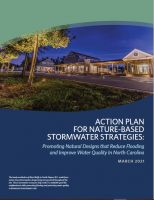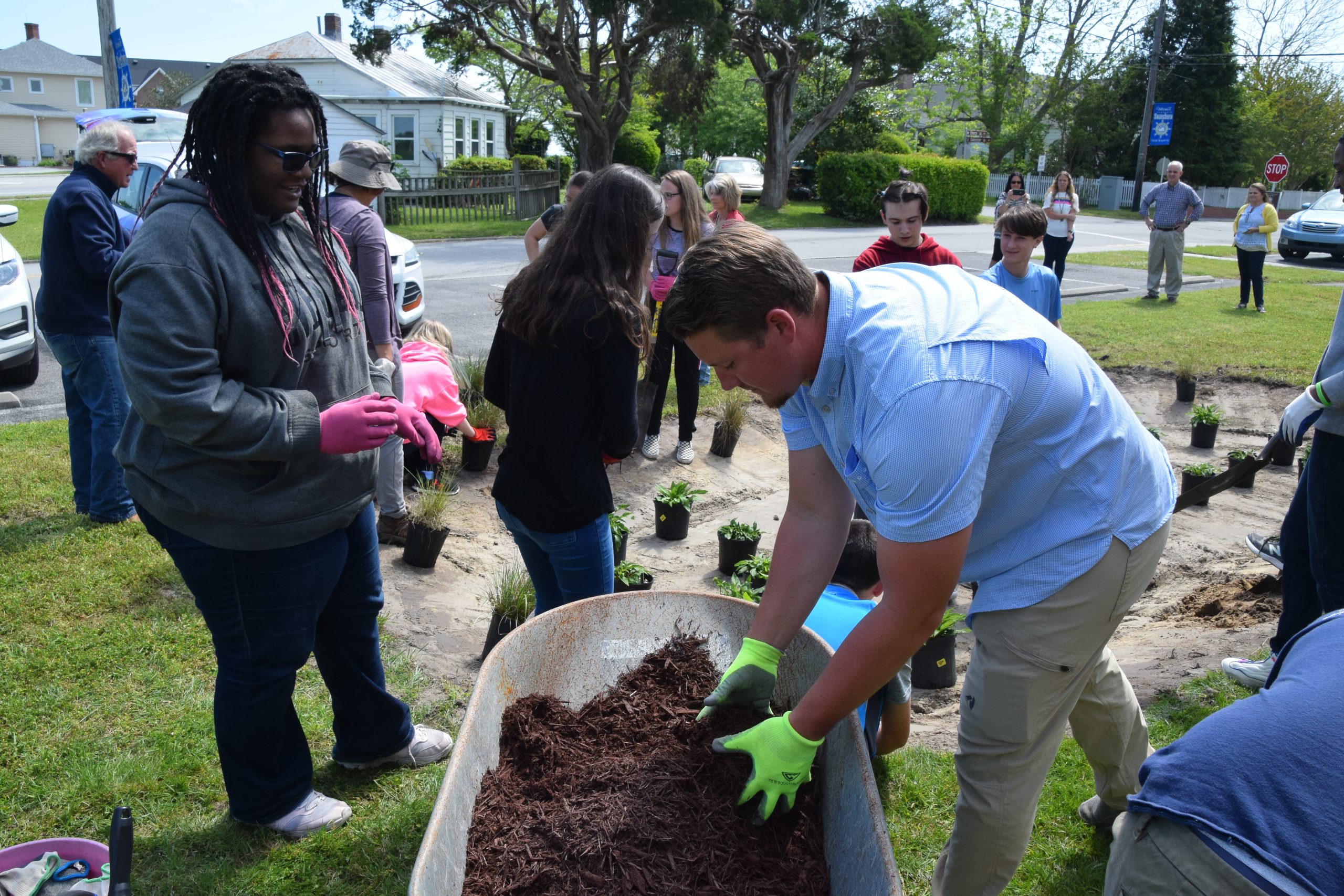
State and local leaders now have access to a guide that details what its creators describe as cost-effective, nature-based strategies to better manage stormwater, reduce the risk of flooding and improve water quality.
The nonprofit North Carolina Coastal Federation released Wednesday its “Action Plan for Nature-Based Stormwater Strategies,” developed with the support of The Pew Charitable Trusts.
Supporter Spotlight
 The plan includes recommendations on how to use nature-based stormwater strategies such as permeable pavement, cisterns and rain gardens to promote infiltration and rainwater reuse, and help reduce stormwater runoff as well as steps government, communities, businesses and nonprofit organizations can take to improve resiliency and water quality.
The plan includes recommendations on how to use nature-based stormwater strategies such as permeable pavement, cisterns and rain gardens to promote infiltration and rainwater reuse, and help reduce stormwater runoff as well as steps government, communities, businesses and nonprofit organizations can take to improve resiliency and water quality.
Yaron Miller, an officer with The Pew Charitable Trusts’ Flood Prepared Communities Initiative, told participants in a press conference that can be viewed on Facebook Watch that last year was the second wettest on record for the state, and communities are looking for ways to deal with the intense rainfall and costly flooding.
“In a fast-growing state like North Carolina, these challenges are often compounded by the fact that traditional development uses impervious surfaces like concrete and asphalt, which prevents rain from soaking into the soil, or pipe stormwater into waterways, which can exacerbate dangerous flooding conditions downstream,” he said. “One proven, cost-effective way to mitigate those consequences is through the use of nature-based stormwater solutions, which allows stormwater to soak into the ground near where it falls.”
Yaron Miller said that these strategies can be applied on small-scale projects such as a rain garden in the backyard or permeable pavers in a parking lot, to efforts to restore natural water flow and infiltration on entire landscapes. The comprehensive blueprint also reflects the findings of the state’s Climate Risk Assessment and Resilience Plan.
“The nature-based solutions are a core strategy for increasing disaster resilience and should be developed right away,” Yaron Miller said.
Supporter Spotlight
The action plan was developed over the course of a year with input from 60 stakeholders — real estate developers, engineers and planners, state agency and local government officials, land managers, academic and legal experts and conservation professionals.
The plan calls on a collaborative approach and state and local governments to lead by incorporating nature-based designs and projects, making these taxpayer-funded investments more resilient to flooding, and helping reduce runoff from storms. It also recommends that state leaders take into consideration that water moves across municipal boundaries and flooding doesn’t stop at city or county lines.
“By looking across regions and accounting for all the factors that influence flooding, watershed planning can help us make coordinated strategic decisions to reduce risk, like the design and placement of nature-based stormwater projects,” Miller said.
While there are examples of communities and businesses using these practices to reduce flooding and improve water quality, the vision is that the plan helps more communities across the state “realize the benefits and become more resilient from Main Street to working lands.”

Todd Miller, the federation’s director, called the plan’s unveiling “a watershed moment” for the state.
“Extreme weather and floods touch all of us. Even if you haven’t been in the eye of a hurricane, you pay for flood and water quality disasters in your taxes and insurance. And when you take a drink, swim or eat seafood, you share my concern for clean water,” Todd Miller said.
He continued that state leaders are taking significant steps to address flood risk — the North Carolina General Assembly spent more than $1.4 billion on hurricanes Matthew and Florence recovery – and lawmakers are now working with the governor to make the state more resilient to climate extremes, and to administer disaster recovery.
“Nature-based stormwater strategies can reduce the repetitive losses caused by floods,” Todd Miller said. “This action plan focuses on how to expand the use of these strategies.”
The recommendations in the plan are based on input from the four stakeholder groups.
“Our stakeholders identified many impediments that curtail the use of nature-based strategies. To sum them up, we must conquer inertia,” he said. “More floods and degraded water quality are inevitable unless we employ nature-based strategies.”
Todd Miller explained that the stakeholders called for engagement and leadership.
“People who own land, homes, businesses, farms, developed property — all recognize the need to work together so that nature-based stormwater strategies go well beyond government mandates and become a part of our culture and commerce,” he said. “Many stakeholders see future economic development opportunities around the design, construction and operation of these nature-based stormwater practices.”
Also imperative is the need to increase public education and outreach as well as professional training on nature-based strategies.
“Until all stakeholders and decision makers understand the utility and cost savings of these strategies, their widespread use will continue to be stymied. Professional workplace training needs to focus on how best to design, construct, retrofit and maintain our land uses to protect and restore and replicate natural landscape hydrology,” he said.
Government needs to lead by example, Todd Miller added. “Policies need to facilitate the use of these strategies in publicly funded projects, when they are the most cost effective and alternative stormwater practice.”
The federal government has a policy in place, and it’s time for state and local governments to follow suit, he said.
“Finally, and most importantly, a statewide framework for value-based watershed management investments is essential,” Todd Miller said. By focusing on flood reduction and water quality enhancements, both objectives are achieved.
Pine Knoll Shores Town Manager Brian Kramer gave what he called real-life examples of how such practices are being put in place in the Bogue Banks town. Pine Knoll Shores worked with the federation, Eastern Carolina Council and University of North Carolina Wilmington’s Environmental Science Department to develop a watershed restoration plan completed in early 2019.
The town’s new approach to flooding is minimizing the pumping of polluted surface water into waterways, which has been done for 40 years during storms or heavy rains, by using infiltration when possible, mimicking the natural flow of water to avoid collecting in flood-prone areas, Kramer said. The town is also trying to manage the water table to create more capacity for additional infiltration.
“We’re trying to do this with help from the state, most notably the Clean Water Trust Fund (now the North Carolina Land and Water Fund), with the Coastal Federation’s assistance,” he said.
Kramer said the alternative to the town’s use of pumps to move water from public roadways, usually into waterways, in an emergency, is to reduce the volume of water by avoiding the addition of impervious surface coverage, using infiltration and adding capacity.
“The value I see in this state plan that the Coastal Federation put together is emphasis on natural features,” he said. He also likes the recommendation for funding for technical specialists, “Because towns like us need it. We don’t have engineers on staff, we need coastal design specialists to help us.”
Kramer noted that the plan stresses the need for public education and projects to be both economically and environmentally feasible, “because if you make these things so expensive, developers won’t use them.”
John Preyer, cofounder and president of the Raleigh-based environmental firm Restoration Systems, told attendees that the “benefit to natural systems is very obvious when you are not only restoring wetlands or restoring a stream, but you’re getting the additional benefit of flood storage.”
He mentioned a recent project to restore more than 5,000 acres at the North River Farms Wetland Preserve in Carteret County, which had been used for agriculture. Rainfall that used to drain into nearby waters in two hours now takes more than two months.

“We’re looking forward to seeing the action plan come to fruition over the next coming years,” Preyer said.
Now that the plan has been released, Todd Miller said there will be an effort to continue educating about nature-based solutions.
“We’ve actually already done some briefings with some of the key agencies to give them a heads up on what some of the key recommendations are in the report,” he added, and a handful of state agencies have been receptive to the idea.
Yaron Miller added that state and local government representatives participated in the workgroups to help inform the plan and the recommendations, so there’s already a level of knowledge but there will certainly be more outreach and getting the word out.
“I think probably what’s most exciting and why we need this watershed planning framework is that it looks like there’s going to be a lot more federal resources being spent on trying to mitigate future flood losses rather than spend all that money on recovery,” he said, also noting the need to get out ahead of disasters rather than getting caught in a cycle of responding to them. Funding from various federal agencies is increasingly prioritized for mitigation and nature-based strategies, he said.







